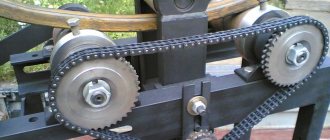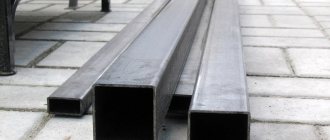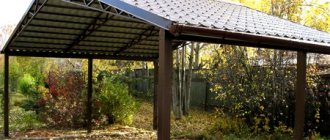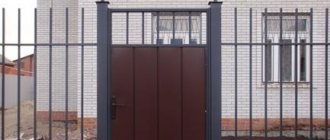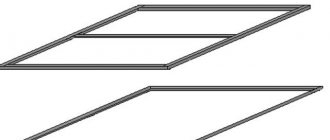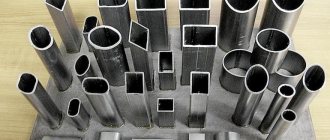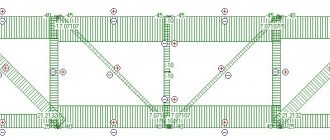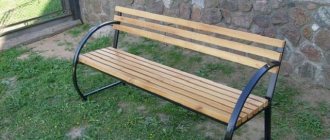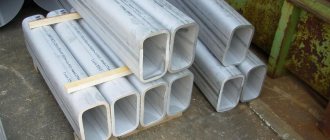Curved profile pipe is widely used in the construction of various structures. The curved profile gives the roof a streamlined shape, is aesthetically attractive when constructing arched structures and openings, and can withstand severe dynamic loads. Buying a profile of the required diameter is not a problem. It is impossible to give a straight metal profile pipe the desired bend without the use of special equipment.
You can bend the profile manually using a gas burner and applying physical force. But even for such a simple operation it is necessary to secure the pipe firmly, select a safe place for heating, and adjust the levers to apply force. It is even more difficult to make several symmetrically curved profiles.
This problem is solved using a special technique - rolling a profile pipe.
What is pipe rolling
For the construction of metal structures, special pipes with a square or rectangular cross-section are used, which have increased strength to static load. Giving these pipes the required shape using a special machine is called rolling. The machine itself is called rollers (roller, pipe bender).
When people talk about pipe rolling on an industrial scale, this term refers to the operation of producing a profile pipe. The blank for obtaining the profile is a round welded pipe, which, by rolling on rollers, is converted into a pipe with a square or rectangular cross-section.
Rolling in production consists of the following operations:
- Preparation of a pipe with a round cross-section from flat rolled metal - the sheet is rolled up and the connecting seam is welded.
- A round pipe is pulled through a roller, deforming it and giving it a cross-section of specified dimensions.
- Carry out quality control of the connecting seam of the resulting profile.
- Additional rolling removes the residual stress of the metal after deformation.
Note! The term “rolling” on an industrial scale has a broader meaning than just a radial change in the shape of the pipe.
A production roller or pipe bender is a machine consisting of 3 or five metal rollers, which are connected into a single mechanism by a drive chain. Such a machine is used in the pipe rolling industry, primarily for the manufacture of the profile itself.
We recommend that you familiarize yourself with: Spiral-wound air duct designs
In pipe rolling production or in professional construction, an electric roller is used. This is a device that consists of several specially fixed rollers and a guide system. Between them, with external force, a metal profile is pulled.
When making pipes, the rolling machine looks like a stationary multi-ton machine. In industrial construction, a roller is an industrially manufactured machine for radius deformation of a pipe.
Details about rolling
You can make the pipe take a different shape using a simple torch. This approach is often practiced, but the employee faces a number of difficulties:
- there is a need for a large lever to change the shape;
- you need emphasis and, as a result, a lot of physical strength;
- It is almost impossible to make the product even; this is due to inaccurate movements and improper distribution of effort.
Manual profile bender
To get the best result, you should use rollers. With their help, a profile pipe can be easily transformed with your own hands. The photos and videos show the features of working with the tool. To familiarize yourself with the result of the tool's work, drawings are presented.
1 Type of machine is designed for radius bending of profile pipes.
Standard machine characteristics:
The maximum pipe cross-section is 40 x 40 x 2, 50 x 25 x 2 mm.
Minimum circle diameters:
- 20x20x2, 25x25x2, 15x15x1.5 –560 mm
- 30x30x2 - 650 mm,
- 40x20x2 - 650 mm,
- 40x40x2 - 1800 mm,
- 50x25x2 - 800 mm.
The maximum arc diameter is unlimited.
Drive type: manual.
Hardened rollers – all 3 pcs.
Price: 25,000 rubles.
2 Type of machine is designed for radius bending of profile pipes, round pipes and strips.
Characteristics of the universal machine:
The maximum pipe cross-section is 40x40x2, 50x25x2 mm.
The maximum cross-section of a round pipe is 32x2.8 mm.
Strip 40x4 mm.
Minimum diameters of a circle of profile pipes:
- 20x20x2, 25x25x2, 15x15x1.5 –560 mm
- 30x30x2 - 650 mm,
- 40x20x2 - 650 mm,
- 40x40x2 - 1800 mm,
- 50x25x2 - 800 mm.
The maximum arc diameter is unlimited.
Drive type: manual.
Hardened rollers – all 3 pcs.
Price: 30,000 rubles.
At the Customer's request, for an additional fee, the machine is equipped with a dial indicator for the production of more accurate all subsequent workpieces.
For an additional fee, the machine can be equipped with a 220-380V electric drive
2 year warranty
Contacts:
Tel: 8-919-831-25-14
Saratov region Engels
Delivery within the Russian Federation.
Industrial rollers
The industry produces machines for self-rolling profile pipes for the needs of private construction. The cost of such devices starts from 25 thousand rubles.
These are portable, compact machines:
- with manual drive;
- electrical devices.
Note! Hydraulic driven machines are used in industrial production. These are heavy stationary machines that have great power.
Standard rollers for home use consist of:
- Three hardened metal rollers. The bottom two are servers. The upper pressure roller presses on the pipe, deforming it.
- Threaded clamping device.
- Stable bed.
- Sturdy metal case.
- Handles for driving the chain drive.
It is easy to equip a manual machine with an electric drive. For some industrial rollers, this modification is provided by the manufacturer. At the consumer's request, the electric drive is installed upon purchase.
However, purchasing an industrial machine for home use is a luxury for most consumers. It is possible to make such a device yourself, provided you have some skills and the availability of component parts.
Industrial and home rollers
Not all modifications of this amazing tool can be used at home. How do you think a profile pipe is made? Of course, with the help of rollers. This is done as follows. The sheet of metal is rolled into a cylinder and the seam is welded. Next, the pipe is passed through rollers. Under the influence of high pressure, the desired profile is obtained.
Electric profile bender
To do the work, enormous effort is required, so the profile pipe is produced using special equipment. Rollers installed in factories weigh more than ten tons. How can you do this kind of work yourself?
Homemade devices for rolling
The pipe bender in the home craftsman's arsenal is not a device that is often used. However, for those craftsmen who are engaged in arranging their own site on their own, rollers are periodically necessary.
Carrying out repair and construction work using bent profiles allows you to create lightweight, durable structures from modern materials. For example, polycarbonate, which is widely used in the construction of greenhouses, gazebos, canopies, and roofs, fits well on a bent metal profile.
A homemade pipe bender is a compact device with dimensions: length - 500 mm, width - 220 mm, height 340 mm.
We recommend that you read: Types and advantages of seamless steel pipes
For production you will need:
- stable base;
- strong body;
- metal rollers;
- chain for transmitting torque to the rollers;
- clamp for adjusting pressure;
- guide pipe.
Note! It is unacceptable to skimp on components. The rolling machine must have sufficient strength and be safe to use.
To make a high-quality pipe bender yourself, you must have skills in working with metal and be able to draw up and read a drawing. With a little effort, you can assemble rollers at home that will not differ in performance from their industrial counterparts.
Types of devices
Changing the profile pipe configuration can be done using equipment of various sizes and configurations. The main difference between rollers for bending profile pipes is the type of drive. According to this parameter, devices can be divided into the following types:
- Manual drive. The simplest devices, the operation of which requires significant physical effort on the part of the master. They are the ones most often made and used at home.
- Electric drive. The most complex devices that are used to give the required shape to even the simplest and thickest profile pipe.
- Hydraulic drive. The most modern and convenient type of device. It is quite easy to use. They do not require the use of physical effort like a hand tool, and at the same time it costs much less than an electric device.
If work on creating complex structures from profile pipes is carried out infrequently, it is enough to purchase or make hand tools. Manual rollers for profile pipes are reliable and simple, and consist of the following elements:
- basic structures, made of durable materials;
- clamping mechanisms that are used to secure the workpiece;
- rollers that perform feeding and bending functions.
The main disadvantage of such a mechanism is the significant physical effort on the part of the master to use it. In addition, such a machine is characterized by low productivity, so it is used only in the household.
An electric machine can also be made independently, but such equipment is quite complex. Has high performance and power. A special feature of the device is an electric drive, which is responsible for feeding and pulling the workpiece.
Modern pipe rollers
For home use and DIY production, preference is most often given to hydraulic machines, which are quite powerful, but can be easily made at home. Such devices are used both in enterprises and for personal needs.
How to make rollers with your own hands?
Homemade rollers for a profile pipe should be:
- reliable;
- mobile;
- economical.
Depending on the frequency of use, a homemade machine can be equipped with an electric drive after its manufacture. The motor power should be no more than 1.5 kW (for operation from a stationary network).
Note! Electric profile rollers cannot be called an economical device. If such a machine is used infrequently, then you can get by with a manual drive.
The manufacture of a machine for home rolling should begin with the assembly of its body. For this, it is recommended to use a channel or profile pipe. The base must be wide enough and stable. The body is rigid, the working part is U-shaped. A nut is welded at the top of the body to install a clamp to adjust the pressure of the deforming roller. The second option is to install a hydraulic jack.
The jack is installed under the feed roller from below. In this embodiment, pressure is applied to the pipe from below, for which half of the installation platform (with one feed roller) is made movable.
The rolling mechanism has its own characteristics. The rollers must be stronger than the pipes that are expected to be deformed. They are made of hardened steel and secured with rolling bearings. Two rollers are installed on the lower platform, on the same plane. They will stretch the pipe.
The deforming roller is installed on top in the U-shaped part of the body. Its position is adjusted with a clamp. The rolling mechanism is connected and driven using a chain drive. The chain can be used from a large bicycle. The sprockets are installed on a rolling and deforming roller and connected to a handle, from which torque is supplied.
We recommend that you read: Novosverdlovsk Metallurgical Company
A guide pipe is installed to hold the pipe in the center.
Stages of roller manufacturing
To install a rolling machine, it is important to use high-quality and durable elements, adhere to the dimensions of the drawing and certain stages of work:
- Base. The most important stage in the manufacture of rollers, which affects the strength and durability of the structure, is the manufacture of a high-quality base of the machine. Therefore, it is recommended to use steel channels or pipes of significant diameter.
- Vertical supports. To manufacture the vertical pores of the machine, it is recommended to use a metal profile with a U-shaped cross-section. A roller mechanism will be installed on the top of the support, which will perform the function of changing the configuration of the profile pipe. It is important that the upper part of the support is strong and reliable. To install it, you need to fix the lower part of the support to the base. It is best to use clamps for this. This fastening method ensures uniform distribution of the deformation force, which is applied to the workpiece, across two rollers.
- Chain mechanism. To give rotation to the rollers, it is necessary to use a chain drive. To make it, you can use sprockets and a chain from an old motorcycle or bicycle. In this case, the parameters of the sprockets must correspond to the configuration of the chain, so it is recommended to take them from one mechanism or carefully purchase them. The chain mechanism must be installed with good tension, and then the handle must be installed. If the work is done correctly, the roller drive mechanism will ensure easy rotation of the shafts.
- Rollers. The main element of the machine is the rollers, which are recommended to be made of durable hardened steel. This will improve the productivity of the machine and ensure a long service life.
Ready-made homemade rollers
The finished structure can be additionally coated with paint to protect the metal from corrosion.
Recommendations from experts
Key points to consider when making rollers for profile pipes:
- When assembling the machine, it is recommended to install radial adjustment, which will allow you to adjust the gap during operation;
- adjustment of the angular gap should be provided;
- For safe operation of the machine, especially with an electric drive, protection should be used on the moving parts of the mechanism.
With the right approach, rollers made at home are in no way inferior to industrial machines.
Features and principle of operation of rollers
Profile pipes are actively used for various construction works. For the manufacture of complex structures, the welding method, bolted or adhesive connection of elements can be used. However, the most reliable way to create complex structures is to use rollers.
Using rollers to bend profile pipes does not require special knowledge and skills. To give the workpiece the required shape, perform the following operations:
- place the workpiece on two feed rollers;
- press the pipe against one bending roller with the required force;
- turn on the transmission mechanism.
When passing through the working area, the profile pipe bends at a certain angle. If the bending angle is insufficient, it is necessary to repeat the manipulation again. It is important to control the clamping force to avoid excessive deformation of the workpiece.
